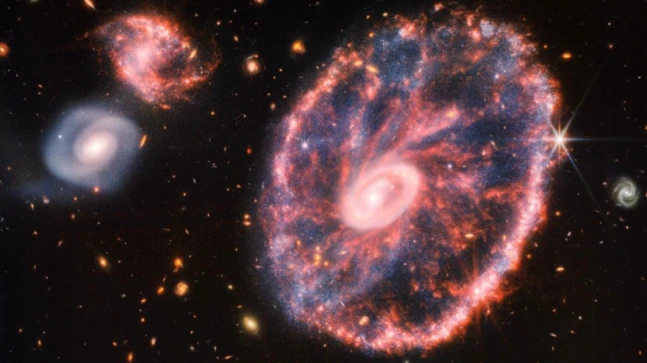James Webb Telescope, which began science operations last month, had peeked into the past and saw a galaxy of almost 500 years, expressing chaos that spin in it. The Flying Observatory has taken new details about the formation of stars and the central black hole in the Cartwheel galaxy.
The most powerful telescope in the world has recovered the pictures of star gymnastics that occurred in the universe that, revealed how galaxy had changed for billions of years. Galaxy looks like a cart, which is the result of a high -speed collision between large spiral galaxies and smaller galaxies that are not visible in this picture. Galaxy Cartwheel is going through the transition phase and astronomers say that it was spiral like the Milky Way, but a smaller collision with a smaller galaxy has caused changing changes and will continue to change.
“The collision is the most affecting the shape and structure of the galaxy. Galaxy cartwheel sports two bright rings and colorful rings around it. Both of these rings expand out of the middle of the collision, such as ripples in the pond after the stone is thrown into it,” said NASA in a statement.
James Webb Telescope, which is located nearly 15.00,000 kilometers from Earth peeked into the past, saw the origin of the universe almost 13 billion years ago. Space aircraft once again performed out of expectations that show striking differences in the quality of images and complicated details collected compared to Hubble, who also saw the Cartwheel galaxy in the past. Space aircraft use an infrared-close camera (NIRCAM) to witness the important wavelength of light that can reveal more stars than those observed in visible light.
Nasa said that galaxies showed many individual blue points, which are individual stars or stars. Nircam also revealed the difference between the fine distribution or the shape of the older star population and the solid dust in the core compared to the forms of clumpy associated with the younger star population outside of it.
Meanwhile, the Ibbb (Miri) medium infrared instrument has revealed the area in a hydrocarbon -rich cartwheel galaxy and other chemical compounds, as well as silicate dust, such as most dust on earth. “These areas form a series of spiral fingers which basically form a galaxy frame. These fingers are proven in previous Hubble observations released in 2018, but they become much more prominent in this webb image,” Nasa said in a statement .

